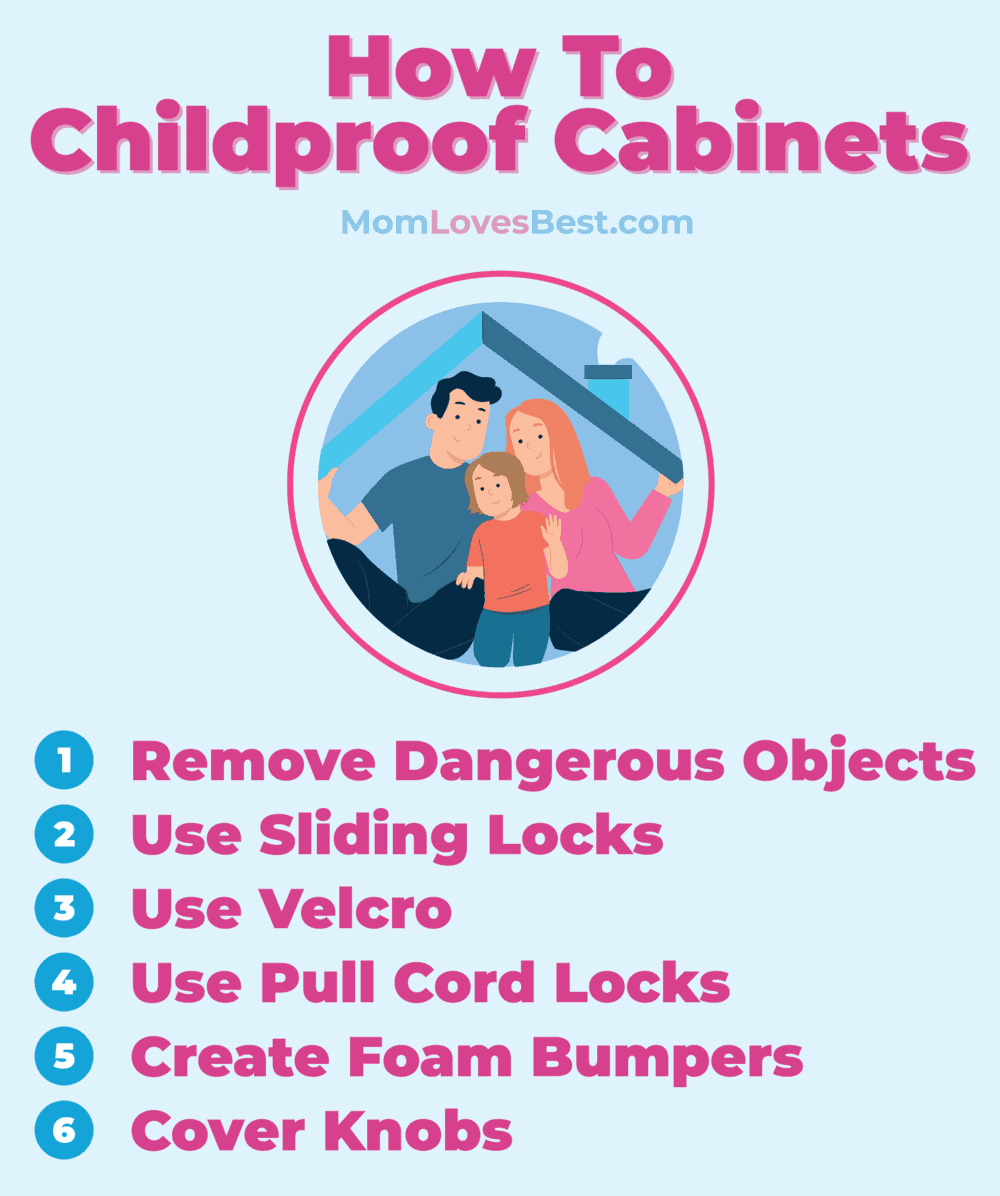Your home should be a haven for your children — but is it?
Whether you’re preparing for your first little one or already have a large brood to take care of, safety is always a concern. We know that ensuring your home is safe can feel daunting and even overwhelming.
Childproofing is one of the easiest ways to minimize potential hazards — and two of the most important furnishings to childproof are cabinets and drawers.
Let’s take a closer look at some of the methods and products you can use for childproofing your cabinets and drawers.
Key Takeaways
- Childproof cabinets and drawers to protect children from potential hazards.
- Remove dangerous objects and store them out of reach to minimize risks.
- Use various locks like magnetic locks, adjustable safety locks, and latch locks for added security.
- Furniture anchors can help prevent furniture tip-overs and keep children safe.
Beginning the Childproofing Process
Where should you begin your journey to plug every electrical socket and cushion in every corner?
I discuss childproofing during the 6-month baby wellness visit. I feel this is a good time because infants haven’t become very mobile yet, and it gives the parent about two to three months to prepare the home.
Editor's Note:
Dr. Leah Alexander, MD, FAAPThe best way to get a general start is to get down on your hands and knees and look at the world through a child’s eyes. Identify any potential hazards. Go through this process room by room.
When you’re down there, you might notice the appeal of drawer and cabinet handles — two of the most common parts of your house to childproof.
How To Childproof Drawers
At first glance, you may think the only danger of a drawer is what lies inside. However, drawers and the dressers that hold them have many risks.
Your child could potentially:
- Access dangerous objects, such as medication or knives.
- Close their fingers in the drawers.
- Use the drawers as a ladder to climb up high.
- Pull a drawer out on themselves.
- Pull a free-standing dresser on top of them.
According to Safe Kids, a nonprofit organization dedicated to preventing injuries in children, “tip-over” injuries have increased 31% in the last decade, with over 12,000 visits to the emergency room reported (1).
How can you childproof your drawers and dressers? Here are six different ideas for you to implement, including a closer look at the many different products and options available.
1. Remove dangerous objects
As great as locks and guards are, children are wild! The older they get, the weaker your childproof-security system will likely become. The best option is to get rid of dangerous objects in the first place.
With children, a dangerous object can mean almost anything, but here are some of the most common household items to remove or place out of reach:
- Cutlery.
- Any pointed or sharp objects.
- Lighters.
- Medications.
- Cleaning supplies.
- Plastic bags.
- Batteries.
- Any potential choking hazard.
- Small electrical items such as flat irons.
Take all of these objects and any others you think are hazardous, and store them high up. Don’t rely solely on drawer locks. Also, it’s crucial that you store any firearms correctly and out of reach (2).
Pro Safety Tip
2. Use magnetic locks
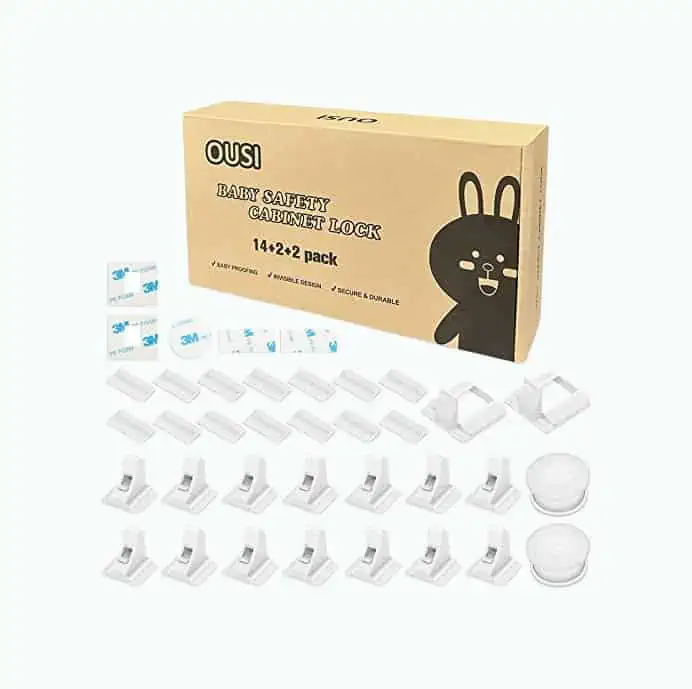
The most popular way to childproof drawers is by using a lock. In recent years, magnetic locks have emerged as an effective solution to keeping your kitchen, bedroom, and bathroom drawers securely shut.
To use, you install a latch with a strong magnet inside the drawer, which prevents it from being opened.
When you place the companion magnet near the drawer, the latch is released, and you’re able to pull the drawer open.
- Pros: Magnetic locks are strong but discreet. You can maintain the look of your drawers without sacrificing safety.
- Cons: Some magnetic locks are easier to install than others. You’ll also have to keep tabs on where your magnetic key is.
3. Use tension rods
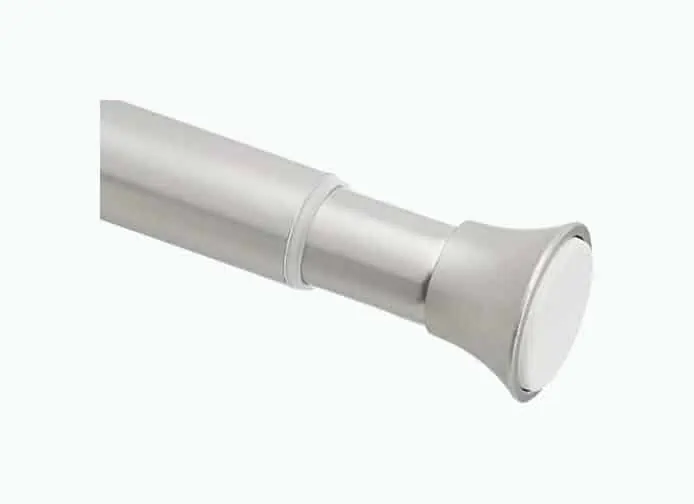
If you have handles on your drawers instead of knobs, use a tension rod vertically through all the handles to secure all the drawers at once.
Tension rods are most often used as curtain rods and come in various styles and sizes. Find one that fits through your handles, and run it all the way down.
You’ll want to make sure you get a tension rod with rubber ends. Secure one end underneath the lip of the countertop so your child cannot easily pull the rod out.
- Pros: Tension rods are relatively inexpensive, and you only need one for each set of drawers. Since you don’t have to install anything, you don’t have to worry about damaging your furniture.
- Cons: Every time you want to open a single drawer, you’ll have to remove the entire rod. As children grow, they may learn how to release the tension rod.
4. Use adjustable safety locks
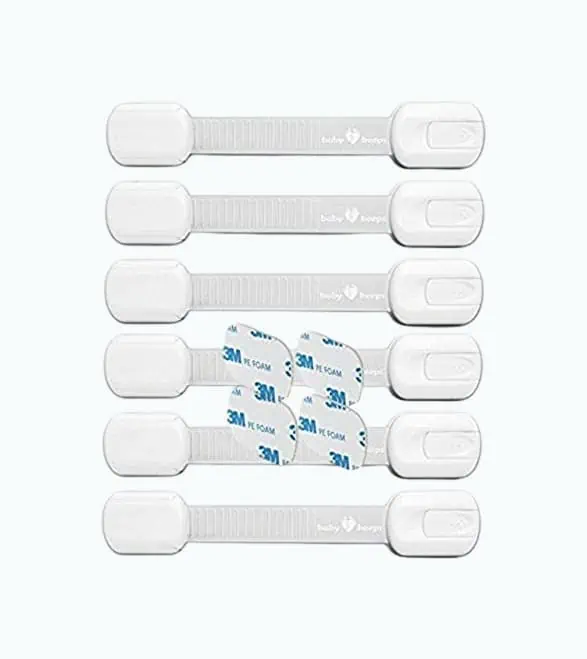
Do you want a single-lock system for multiple drawers around your home? We recommend an adjustable lock.
These locks have two plastic anchors on either side and a silicone or plastic strip in the middle. You attach one end to the side of the dresser or counter and the other end to the front of the drawer. Then, you pull the strip tight enough to keep the door closed.
Just click the button on the door to release the lock.
- Pros: You can use an adjustable safety lock on a wide variety of drawer sizes. They’re also easy to install and open.
- Cons: Adjustable locks, while able to secure the drawer, often leave a gap your little one can squeeze their fingers into. They may also be more challenging to place on the drawers in your kitchen.
5. Use latch locks
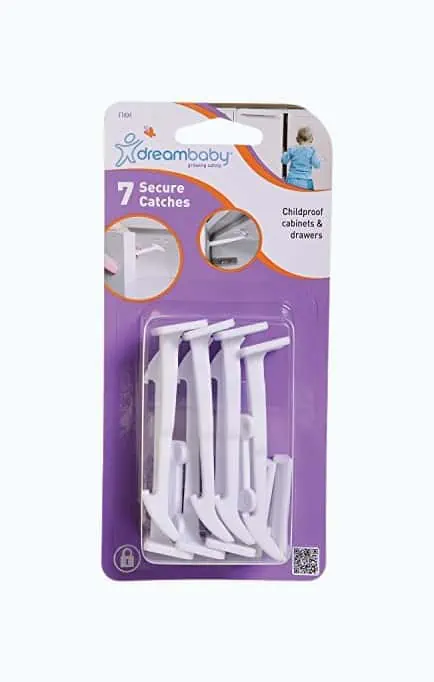
Latch locks are a classic.
Latch locks attach near the top of the drawer you are childproofing. They hook securely to the top of a special piece of plastic you attach above the drawer.
When the latch catches, you cannot pull the drawers open.
- Pros: Latch locks are widely available in a variety of styles. They were designed specifically for drawers, so you know they’ll work.
- Cons: Latch locks often require that you drill into your cabinets, and they take some time to install. If you opt for latch locks, make sure to give yourself some time to install them.
6. Use furniture anchors

There’s a reason we refer to a dresser as a “chest of drawers.” While you may want to focus on the kitchen, you also need to secure free-standing furniture.
If your baby pulls out the drawers, they can use them to climb up. The added weight increases the risk of the furniture tipping over, causing serious injury.
Use furniture anchors, also called anti-tip straps, to secure dressers, dressing tables, or shelves.
Secure the straps to the wall and the piece of furniture. If the furniture begins to tip over, the straps will prevent it from falling.
How To Childproof Cabinets
Cabinets and cupboards can be scary places when you have children. They’re the gateways to large areas full of fascinating things for your child to get in trouble with.
People often use cabinets to house hazardous products.
Your child could potentially do any of the following:
- Ingest poisonous liquids or products, such as cleaning liquids or medications.
- Hurt themselves with heavy objects, such as pots and pans.
- Slam their fingers and toes in the doorway.
- Get trapped in larger crawl spaces.
Just as with drawers, there are many different ways to childproof your cabinets.
1. Remove dangerous objects
Here are a few objects you may need to remove from your cabinets:
- Cleaning liquids and powders.
- Medications.
- Appliances with long cords.
- Plastic bags.
- Fragile dishes.
Because of brightly colored laundry detergent pods, there have been more cases of accidental detergent ingestion (3).
Editor's Note:
Dr. Leah Alexander, MD, FAAPYou also want to pay attention to non-dangerous products with the potential for trouble.
These include:
- Bags of flour or sugar.
- Food boxes that your child can easily open.
- Aluminum foil and plastic wrap.
If you do not have other storage options, there are ways you can make your cabinets more secure.
2. Use sliding locks
Many of the locks we’ve already mentioned for drawers can be used on cabinets, including the magnetic lock systems. However, sliding locks were designed primarily with cabinets in mind.
A sliding lock goes around two different cabinet knobs or handles. It’s a U-shaped device, similar to a large bike lock. Every model is different, but you generally press on the lock apparatus to pull it off the larger mechanism, freeing you to open the cabinet doors.
- Pros: Sliding locks are inexpensive and easy to use. Since cabinets generally have two different doors, sliding locks ensure you secure both without needing extra equipment or materials. Unlike other cabinet-specific locks, they don’t feature any cords that could harm your baby or toddler.
- Cons: Sliding locks often leave gaps for little fingers. And older children can figure out the system pretty quickly, so you might have to upgrade to another method once they reach a certain age. Also, some cabinets don’t have handles or knobs, which means you’ll need to use a different system.
3. Use Velcro
Velcro is an excellent option for parents who don’t need or want an intense lock system for their cabinets.
This ingenious trick starts with Velcro strips, with an adhesive material on one side and Velcro on the other. Open each cabinet door and place the two strips on the inside frame, one on the top and one on the bottom. Then add two more Velcro strips on the inside of the door opposite the others.
The Velcro will lock together, preventing small hands and arms from pulling the door open.
- Pros: With Velcro, you don’t have to worry about drilling holes into your cabinets. You can even find Velcro with adhesives you can remove easily.
- Cons: While you can find Velcro of varying strengths, your door will still open if a child uses enough force. Velcro is a good option for babies and toddlers but may prove ineffective as your child’s arms get stronger.
Sticky Tip
4. Use pull cord locks
Pull cord locks are suitable for cabinets with round knobs placed side-by-side. They’re pretty simple — think of a backpack you pull closed with a cord.
To install, place the cord around both knobs. Then, press on one of the attachments and slide it all the way up so the cabinet is secure. You’ll be left with a single, long piece of the cord. To release, press the button and slide it down again to widen the circle.
- Pros: Unlike some other do-it-yourself methods to wrap cords around both knobs, you cannot undo pull cord locks. They won’t loosen, so you don’t have to worry about your child prying them off.
- Cons: You should always be wary whenever cords or long strings are available to your child, as they pose a potential choking hazard. Make sure you get a high-quality cord lock that works properly and doesn’t leave too long a strand when locked.
5. Create foam bumpers
Children can have way too much fun slamming cabinet doors! This is dangerous because no one wants those little fingers bruised or broken from a slammed door. If you have a cabinet you don’t need to lock, but you don’t want your child to slam it, create your own foam bumper.
You can do this easily with a hollow pool noodle. Simply cut off a section of a pool noodle and slit one side. Then, wrap the slit around the door, high up where your child can’t reach it.
6. Cover knobs
Are the knobs on your cabinet especially large? Prevent bruises and goose eggs on your child’s forehead by covering up the knob with something soft. Tennis balls split on one end are great, as are crocheted covers or soft fabrics attached with a rubber band.
- Pros: You get to prevent some problematic bumps from a tipsy-topsy toddler. You can also use the covers on doorknobs you don’t want to turn.
- Cons: Knob covers are not always the most attractive — a major décor faux pas!
Other Childproofing Tips
Now that you’re armed with some essential knowledge on childproofing your cabinets and drawers, it’s time to take your skills to the next level.
- Keep an eye out: If you’re worried about your child figuring out how to open drawers and cabinets, try to avoid opening them where your child can see. Kids copy everything you do!
- Use fun distractions: Include something fun and safe in an area with locks, like a basket of colorful kitchen towels. By giving them something to do, your child may be less likely to turn their attention to breaking past your security systems.
- Talk to them: As your child grows older, make sure to discuss why certain things are off-limits. It’s an excellent opportunity to discuss boundaries and how they can take control of their own safety.
Remember That Supervision is Essential
Nothing can replace a watchful eye. Always supervise your children in places with potential hazards.
As you watch your child, you’ll be able to prevent them from getting into places they shouldn’t be and understand their mindset a little bit better.
If things are especially hectic, we suggest you use baby gates and barriers to prevent your child from accessing areas you don’t want them to go.


